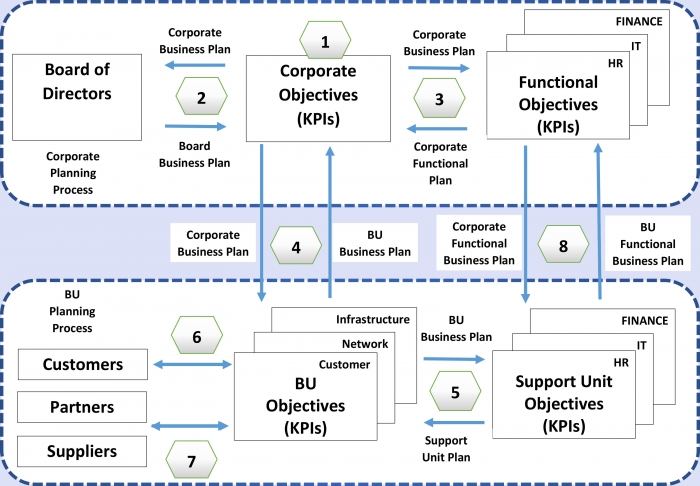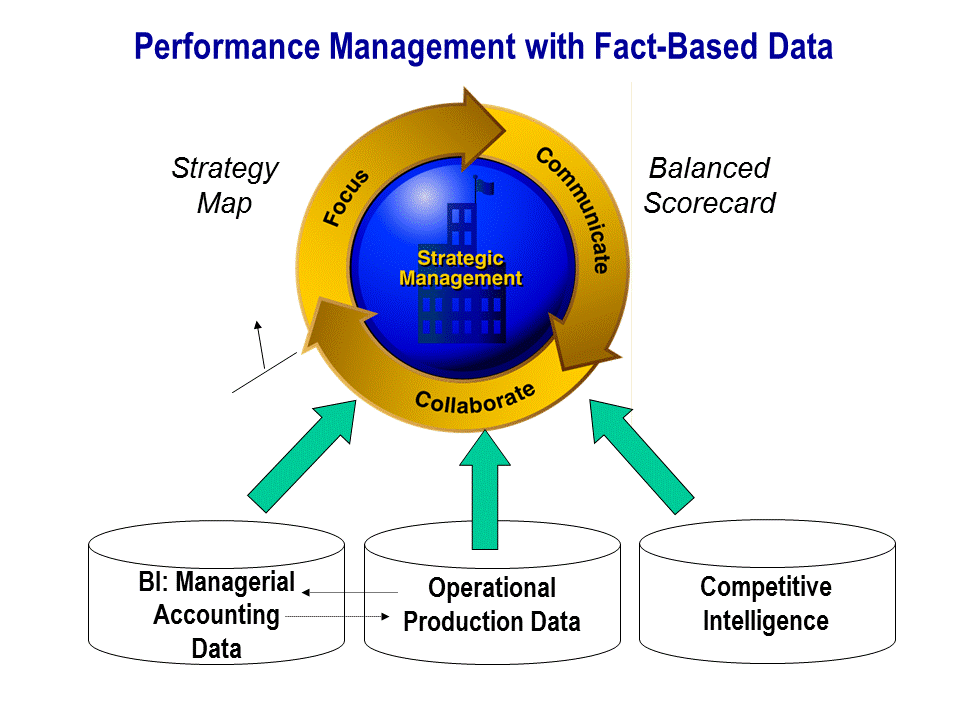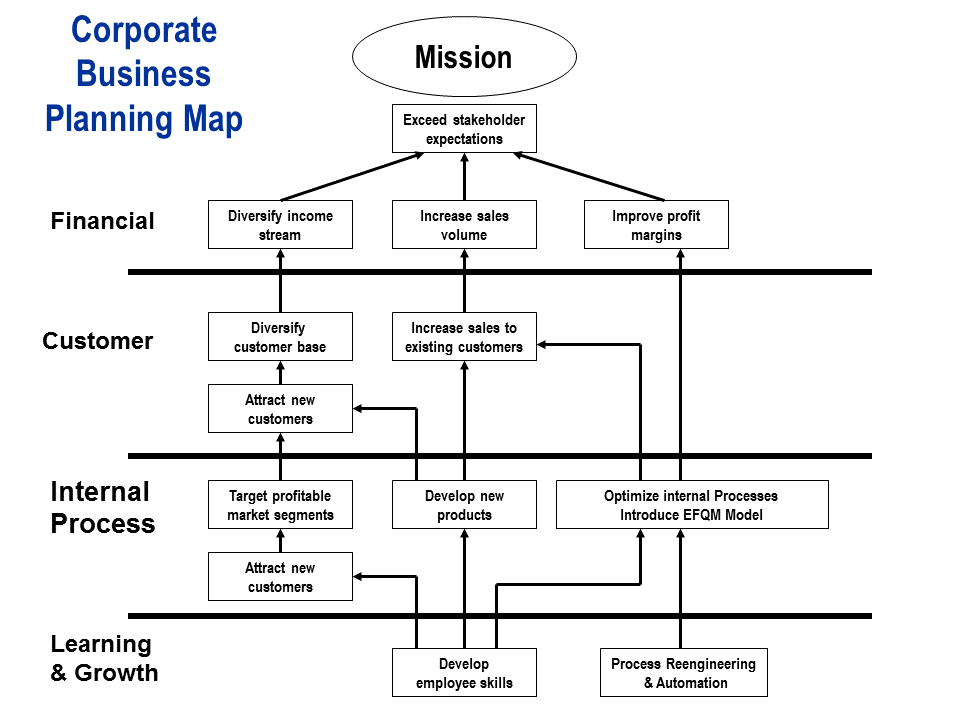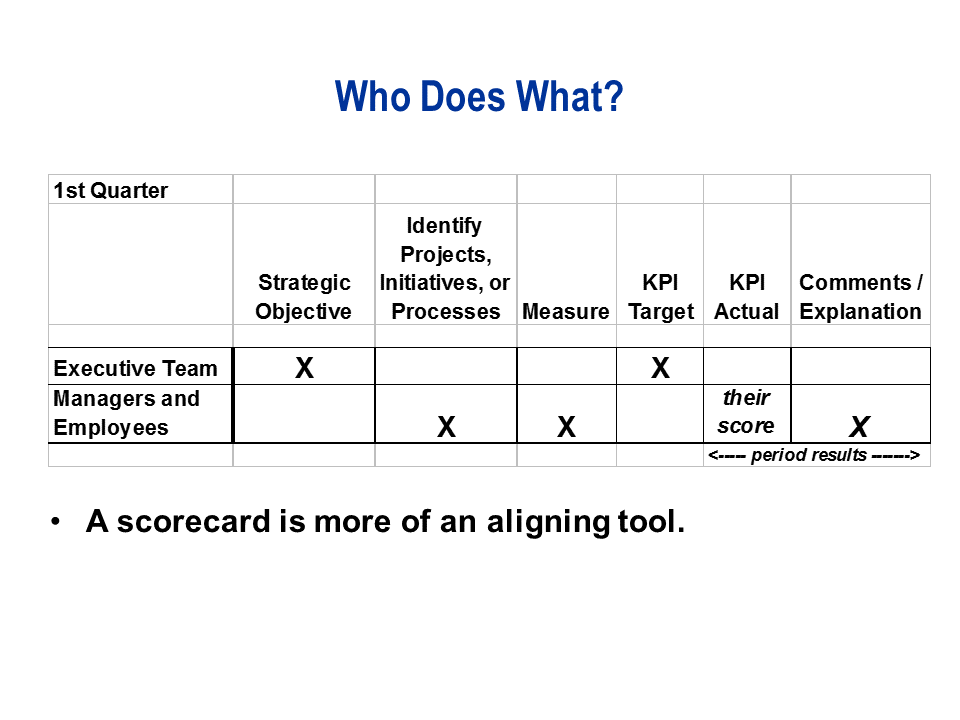Let us consider the Performance Management (PM) Process Cycle in an organization which has adopted the Balanced Scorecard business planning and control methodology and, in particular, in implementing its Corporate Mission.
People can effectively implement the Mission only when they clearly understand it and can see how they contribute to its achievement.
Employees and managers should be provided with tools to align their work and should be recognized for their contribution to the organization’s success.
The executive management team struggles with questions like:
- How do we decide where to place our emphasis and priorities?
- How do we balance our actions and allocate our resources over time?
- How can we confirm that our decisions are actually turned into actions?
- How do we determine whether our decisions materialize into effective actions and into our expected improved results?
A mission-focused organization enables targeted

feedback on managing performance by defining KPIs, setting targets, measuring results and continually adjusting business plans to reflect reality - based on hard facts.
Performance management involves people knowing that all members of their organization are focusing, communicating and collaborating on executing the mission from a single vantage point.
The performance management process contains three elements of an iterative cycle, like a wheel with three arcs: focus, communicate and collaborate.
Focus. The process of managing performance begins with making choices and focusing on what is important. There will never be enough money or resources to chase every opportunity or market on the planet.
At the focus stage, the corporate vision and hence strategic projects (aiming at evolving the corporate mission) are linked to the budgeting process.
 Communicate with Feedback. The process of managing performance continues with communication. This context is reserved for senior management articulating the business plan to its employees. Along comes the all-important feedback from business units and employee teams.
Communicate with Feedback. The process of managing performance continues with communication. This context is reserved for senior management articulating the business plan to its employees. Along comes the all-important feedback from business units and employee teams.The scorecard is the key tool for reinforcing communication and for navigating the steps outlined in the business plan.
By integrating, distributing and analyzing enterprise-wide information, an organization gains the power to act on this information — ahead of its competitors.
The goal is to communicate the business plan to the entire workforce and empower employees to strive to accomplish its targets proactively, before events occur that demand a reaction. To stay ahead, individuals must draw on their organization’s business intelligence to make decisions based on hard facts that are timely.
Collaborate. The process cycle of executing the Mission continues with collaboration.
- The cycle never actually ends; it is a continuous iterative loop.
What happens, however, when an organization’s strategy to execute its mission, and ultimately its vision, is unclear?
- It results in wasted energy.
- The same happens when executives, managers and operatives are misaligned!
The four perspectives of the balanced scorecard are very useful in simplifying what otherwise would be a difficult task. That task is to take each of the objectives that were isolated and link them together in a meaningful manner.
The sequence of the four perspectives must make very good sense.

The top perspective (i.e., the financial perspective for commercial companies and the customer/ stakeholder view for the public sector organization) is the beneficiary of the strategic objectives in the three perspectives beneath it.
The bottom perspective, the learning and growth (or enabling assets) perspective, is the most foundational, not unlike the foundation for a house.
It is useful to think about the learning and growth perspective as not exclusively referring to people.
Expand your perception to include:
- Employee competencies and competences: How would we execute optimally our processes?
- Culture: How can we achieve a stage four tribal leadership culture?
- Improvement and technology capabilities: Which of our processes need re-engineering and how can technology give us an edge?
Ask yourselves:
Who Should Define and Construct the balanced scorecard —Executives or Employees?
There are two schools of thought for implementation:
- A top-down strategy map is cascaded down and deployed at all levels of the organization with little modification, to ensure aligned behaviour and make everyone aware of the larger picture.
- A decentralized approach, where each business group or function can adapt to encourage buy-in and allow employees to develop a sense of belonging and involvement.
- The best approach lies in between these two extremes.
- This is not an us-versus-them game.
- A key determinant of successful scorecard implementations is employee involvement.
- The executives must initially construct the balanced scorecard map in order to derive the themes (ultimately the top objectives) and their interconnections.
- The employees then select the appropriate measures they believe will best report progress toward achieving the strategic objectives.
- The executives’ next role is to approve the measures and, more importantly, assign targets. The targets should be set with a golden rule spirit of not too high or too low—both are demotivating— i.e. ambitious and stretching but just right and achievable, so that measurable progress can be made.
- During each reporting period, the employee teams/units try their best to achieve the KPI targets.
- Finally, each employee team/unit, or alternatively the KPI owner, accountable for a given measure, explains why the score hit, exceeded, or fell short of the KPI target and whether the difference was within typical and acceptable variation (to prevent unnecessary and often wasteful oversteering) or truly an outlier worthy of corrective action.

19.2.2016



